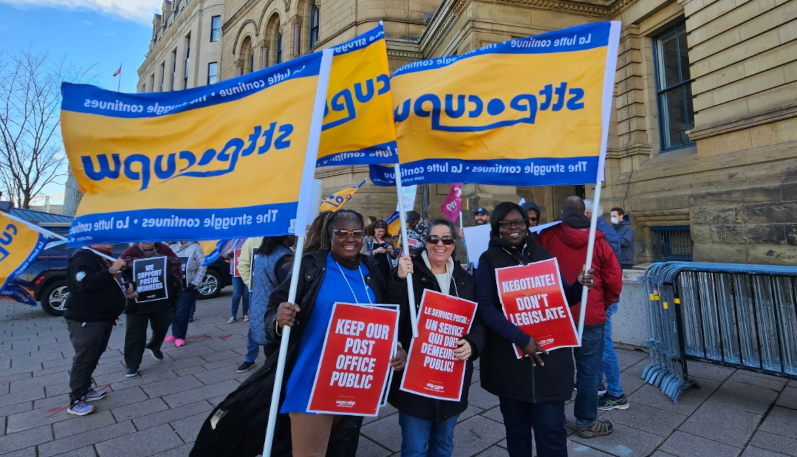On November 15, 55,000 postal workers walked off the job. After a year of failed negotiations with Canada Post, the two sides are still far apart.
Key Demands
The higher cost of living has had a real impact on postal workers, who haven’t seen an increase in several years. One worker, Bryan, said that being a postal worker used to be a good wage. In recent years, inflation has eaten a hole in his and other workers’ pockets. They are demanding wage increases in line with inflation and that Cost of Living Adjustments (COLA) be rolled into their basic wage rate.
A key demand is that short-term disability payments be increased from 70 percent to 80 percent of wages and that Injury on Duty payments be increased to 88 percent. At a recent rally in Surrey, one postal worker talked about the physical toll of being a postal worker — “most of us have had injuries at some point,” he said. Getting injured on the job is all too frequent, with pressure to deliver more and bigger packages. With recent changes to the sorting process, with increased time and pressure on postal workers to deliver long routes and hours, this is even more the case.
Other key demands are related to protecting the well being of workers and for protections against technological change and against contracting out. Workers are demanding 10 additional paid medical days and to allow them to be banked. In addition, they want to see significant improvements to their group benefits plans and precautionary cessation of work for pregnant and breastfeeding employees.
Union Militancy Wins Paid Maternity Leave
In 1981, CUPW was the first union in Canada to win paid maternity leave for employees, winning this important victory for generations of women. 23,000 workers walked off the job on June 30, 1981 and were on strike for 42 days. Their key demand was for 17 weeks of paid maternity leave. They won full pay for the first two weeks and a top up of unemployment benefits for the next 15 weeks, earning 93 percent of their wages. This victory paved the way for all women in the public service and created a precedent, which led to all women workers in Canada winning these rights.
Separate Sort from Delivery Contentious
Canada Post has instituted a new system for mail sorting, called “Separate Sort from Delivery” (SSDS), which has been a contentious issue among workers we talked with. Everyone knows that trying to talk to an automated system is far worse than talking to a person — a person will try to solve a problem, a computer will do what it is programmed to do. SSDS is computerized sorting. It won’t “know” the local details of a route, so will produce less efficient routes. Key issues are that it adds several steps in the process of sorting, with more people involved and takes away the mail deliverer’s autonomy. Workers derided the system as very inefficient and a ploy to divide workers. How many company and government plans to use computers to replace workers have been a total disaster? Just look at the federal government’s Phoenix pay system that 13 years later, and after spending $3.5 billion, is still messing up workers’ wages. Canada Post sees SSDS as a step to privatization. A key demand is the full elimination of this system.
Gigifying the Post Office
In CUPW’s last two strikes, in 2011 and 2018, workers were legislated back to work. A two-tier wage and benefits system was put in place when workers were legislated back to work in 2011, a major bone of contention with workers. New hires are brought in at lower wages and with fewer benefits, a union-busting tactic. This is an ongoing issue in the current contract negotiations. Canada Post is trying to “gigify the Post Office,” says CUPW President Jan Simpson. They want to hire part-time workers at lower wages to work weekends delivering parcels, following the Amazon model.
This time around, workers may not be legislated back to work. The political climate is different with the Liberals having a precarious hold on power and the other parties unlikely to press for this. The Conservatives are pretending to cosy up to the working class (that is until they win power). The federal government has their top mediator, Peter Simpson, on the case and five days into the strike, the union said the employer is finally making some concessions, apparently for the first time in over a year of discussions. However, there are major gulfs in the vision of the Post Office between workers and the bosses.
What may be more likely, if the mediation does not bear fruit, is for the government to resort to mandatory arbitration, as they did to the rail workers earlier this year and more recently with port workers.
Competing Visions for Post Office
Postal workers have come up with innovative proposals to expand the Post Offices including bringing back postal banking. Many smaller and rural areas have no banks but do have a post office. Of course, the Liberals and Conservatives won’t agree to this as they are both friends of Bay Street. In contrast, the bosses want to cut services and bring in a “flexible” (read gig) workforce that works 7 days a week at lower wages to compete with the likes of Amazon. Reconciling between these competing visions is not possible. It will require a militant, fighting union to overcome Canada Post management and win good wages and conditions and an end to the exploitative practices of management, including the reviled 2-tiered system.
This time around (unlike in 2011 and 2018) the postal workers are not relying on rotating strikes. They are out everywhere and have agreed to deliver only government cheques for pensions, unemployment insurance and child care benefits.
Their determination is strong and their militant, fighting history, for those who remember it, will be a good reminder of how to win.




